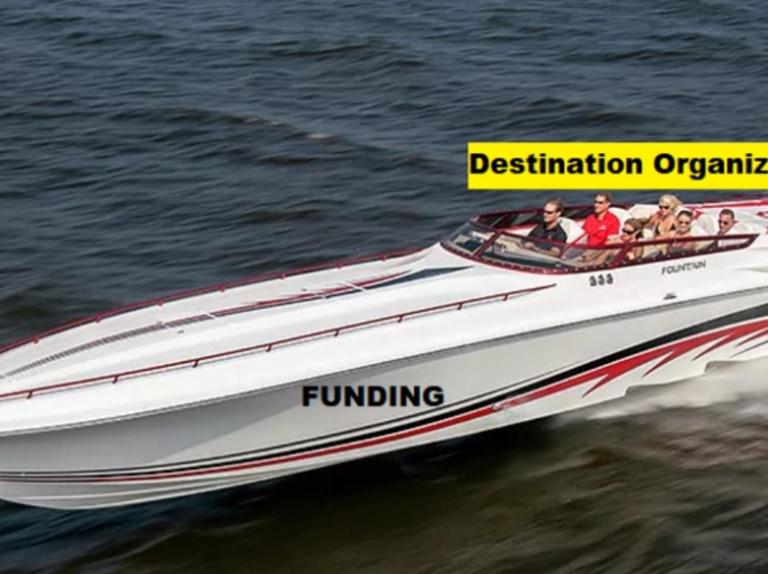
By Andreas Weissenborn, Destinations International
After a year of tumultuous “will they or won't they fund us,” questions, the United States Congress finally included destination organizations to be eligible for Payment Protection Program (PPP) funding through the passing of H.R. 133 the Consolidated Appropriations Act, 2021. A lifeboat? Definitely! However, this is to merely keep us afloat and we are still a long way away from shore.
What keeps us up at night with constant anxiety is funding; not just with recovery funding but maintaining and gaining a tectonic shift in accelerated funding. Broadly we repeatedly ask, “How though?” Our advocacy team has put forth our take on what a community benefit funding model should look like but is it possible to skirt around this and grow in a manner seldom seen in the nonprofit sector? If PPP was a life raft, then we want to build a speed boat.

To be fair, what this is proposing is not for long-term funding, but that is not the point. To connect with one of my favorite fascinations of space, we need funding that equates to the rocket boosters of any spaceship, raw power to simply get us out of the gripes of gravity and then detach and drop back down to earth. Fortunately, such examples do exist, and we should begin to take lessons from Silicon Valley and the abilities of venture capital (VC) funding seeds.
The need for VC funding usually stems from an organization or individual who either figures something (problem, workflow, market deficit) out, then asks for money or solves an existing problem and leverages an existing business model. When you declare that your destination organization a community shared value, you are answering four fundamental problems in particular. Every destination needs to compete and every community needs its destination to be seen. I believe this could make us the perfect candidate for VC funding but with a twist.
Instead of hedge funds or super-wealthy individuals making the initial seed, what if we developed a one-time model where the community (residents) provide the seed? Let me lay it out in five steps.
Stage 1: Seed Capital
This is where our destination organization leaders focus on convincing the community investors (residents) as to why destination promotion is worthy of their support. Hopefully, if they follow our work, they should at least have a leg up in expressing the need for destination promotion, the solutions the sector can provide, and the placemaking it builds within a community. More importantly, showing how we can grow to be a sustainable solution but equally profitable one towards economic impact. Where would I target the money to come from as a one-time seed? The one thing that links all citizens, taxes, and more importantly as a voluntary one-time percent donation of a resident’s tax return towards destination promotion with the possible ROI being lowering of taxes paid on the following year if successful. That is the sell.
Stage 2: Startup Capital
No different from the work we already do with our strategic planning for our destination organizations. We would begin to demonstrate our sample “product” of what a campaign would look like or the booking of a major city-wide event for our destination. Fine-tuning the language and services to meet the needs of the community.
Stage 3: Early-Stage Capital
Now we can begin to demonstrate the worth our efforts have incurred. Event impact reports of the new money received from our sales activities, marketing ROI on our ability to attract visitors from beyond our borders, and growth across admissions for local colleges, workplaces, and new home purchases. From here, we begin to show how our impact is not just on our residents but now the greater economic development community and sets us up for our next round of funding.
Stage 4: Expansion Stage Capital
With traction beneath our feet, we can now pivot our convincing from the resident investors to those in the broader business community, and more importantly, every entity that benefits from our efforts. This includes clothing, pet and liquor stores. We should be convincing them, as we do our residents, on how our methods work and how investment in us will lead to growth in their perspective sectors. A similar seed would need to be planted, and a percentage donation of the business’s income taxes with the hope of their following year’s taxes being lowered upon success or profits have risen accordingly.
Stage 5: Mezzanine/Pre-Public Stage
At this final stage, our argument and worth should be sound. Our preparation for going “public” would be a two-prong approach to our deliveries of a service. The first outlining our building a sense of place for our community (Gross National Happiness scores, lifestyle scores, and branding) backed up with our economic ROI we returned to the community. A portfolio of investments would need to be constructed for every entity responsible for seeding to garner confidence in the return they would be getting.
Public
In the end, what we are building toward is a rapid infusion of funding towards destination organizations that both create awareness and equity on both sides of residents and destinations and helps bring future funders to the table for destination promotion. It is also a risk to but would be a worthy endeavor towards our way back into the next normal. The mechanics of VC funding has risen many of the commodities in our day to day, maybe destination organizations can benefit from this same model.

